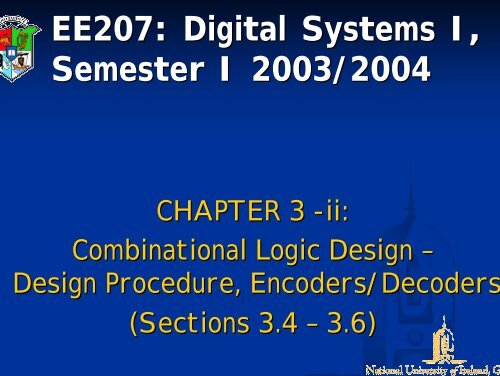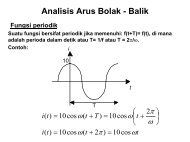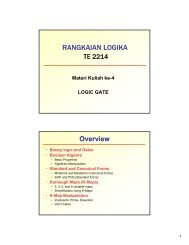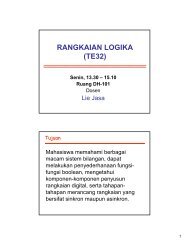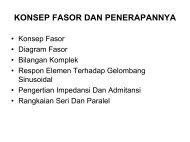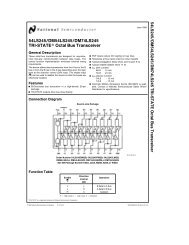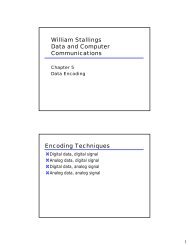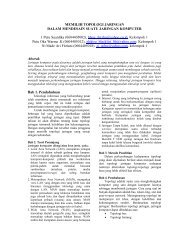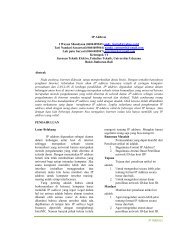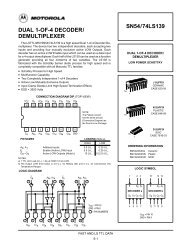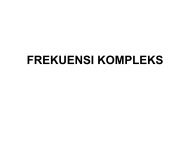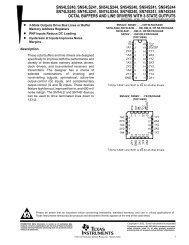Create successful ePaper yourself
Turn your PDF publications into a flip-book with our unique Google optimized e-Paper software.
EE207: Digital Systems I,<br />
Semester I 2003/2004<br />
CHAPTER 3 -ii: ii:<br />
Combinational Logic Design –<br />
Design Procedure, Encoders/<strong>Decoders</strong><br />
(Sections 3.4 – 3.6)
Design Procedure<br />
Code Converters<br />
Design Procedure<br />
Code Converters<br />
Binary <strong>Decoders</strong><br />
Overview<br />
Binary <strong>Decoders</strong><br />
Expansion<br />
Circuit implementation<br />
Circuit implementation<br />
Binary Encoders<br />
Priority Encoders
Combinational Circuit Design<br />
Design of a combinational circuit is the<br />
development of a circuit from a<br />
description of its function.<br />
Design<br />
Starts with a problem specification and<br />
produces a logic diagram or set of<br />
boolean equations that represent the<br />
circuit.
Design Procedure<br />
1. Determine the required number of inputs<br />
and outputs and assign variables to them.<br />
2. Derive the truth table that defines the<br />
required relationship between inputs and<br />
outputs.<br />
3. Obtain and simplify the Boolean function (K-<br />
maps, algebraic manipulation, CAD tools, …). ).<br />
Consider any design constraints (area, delay,<br />
power, available libraries, etc).<br />
4. Draw the logic diagram.<br />
5. Verify the correctness of the design.
Design Example<br />
Design a combinational circuit with 4<br />
inputs that generates a 1 when the # of<br />
1s equals the # of 0s. Use only 2-input 2 input<br />
NOR gates<br />
…
ore Examples - Code Converters<br />
Code Converters transform/convert<br />
information from one code to another:<br />
BCD-to BCD to-Excess Excess-3 3 Code Converter<br />
Useful in some cases for digital arithmetic<br />
BCD-to BCD to-Seven Seven-Segment Segment Converter<br />
Used to display numeric info on 7 segment<br />
displays
BCD CD-to to-Excess Excess-3 3 Code Converter<br />
Design a circuit that converts a binary-<br />
coded-decimal coded decimal (BCD) codeword to its<br />
corresponding excess-3 excess 3 codeword.<br />
Excess-3 Excess 3 code: Given a decimal digit n, , its<br />
corresponding excess-3 excess 3 codeword (n+3) 2<br />
Example:<br />
n=5 n+3=8 1000 excess-3 excess<br />
n=0 n+3=3 0011 excess-3 excess<br />
We need 4 input variables (A,B,C,D) and 4<br />
output functions W(A,B,C,D), X(A,B,C,D),<br />
Y(A,B,C,D), and Z(A,B,C,D).
BCD CD-to to-Excess Excess-3 3 Converter (cont.)<br />
The truth table relating the input and output variables is shown below<br />
Note that the outputs for inputs 1010 through 1111 are don't cares cares<br />
(n<br />
shown here).
Maps for BCD-to-Excess-3 Code Converter<br />
he K-maps K maps for are constructed using the don't care terms
CD-to CD to-Excess Excess-3 3 Converter (cont.
Another nother Code Converter Example:<br />
CD-to CD to-Seven Seven-Segment Segment Converter<br />
Seven-segment Seven segment display:<br />
7 LEDs (light emitting diodes), each one<br />
controlled by an input<br />
a<br />
1 means “on”, 0 means “off”<br />
Display digit “3”?<br />
f<br />
g<br />
b<br />
Set a, b, c, d, g to 1<br />
Set e, f to 0<br />
e<br />
d<br />
c
CD-to CD to-Seven Seven-Segment Segment Converter<br />
Input is a 4-bit 4 bit BCD code 4 inputs (w,<br />
x, y, z).<br />
Output is a 7-bit 7 bit code (a,b,c,d,e,f,g) that<br />
allows for the decimal equivalent to be<br />
displayed.<br />
a<br />
Example:<br />
Input: 0000 BCD<br />
Output: 1111110<br />
(a=b=c=d=e=f=1, g=0)<br />
f g<br />
e<br />
d<br />
c<br />
b
BCD<br />
BCD-to<br />
to-Seven<br />
Seven-Segment (cont.)<br />
Segment (cont.)<br />
Truth Table<br />
Truth Table<br />
11100X0<br />
11100X0<br />
0111<br />
0111<br />
7<br />
X011111<br />
X011111<br />
0110<br />
0110<br />
6<br />
1011011<br />
1011011<br />
0101<br />
0101<br />
5<br />
0110011<br />
0110011<br />
0100<br />
0100<br />
4<br />
1111001<br />
1111001<br />
0011<br />
0011<br />
3<br />
1101101<br />
1101101<br />
0010<br />
0010<br />
2<br />
0110000<br />
0110000<br />
0001<br />
0001<br />
1<br />
1111110<br />
1111110<br />
0000<br />
0000<br />
0<br />
abcdefg<br />
abcdefg<br />
wxyz<br />
wxyz<br />
Digit<br />
Digit abcdefg<br />
abcdefg<br />
wxyz<br />
wxyz<br />
Digit<br />
Digit<br />
XXXXXXX<br />
XXXXXXX<br />
1111<br />
1111<br />
XXXXXXX<br />
XXXXXXX<br />
1110<br />
1110<br />
XXXXXXX<br />
XXXXXXX<br />
1101<br />
1101<br />
XXXXXXX<br />
XXXXXXX<br />
1100<br />
1100<br />
XXXXXXX<br />
XXXXXXX<br />
1011<br />
1011<br />
XXXXXXX<br />
XXXXXXX<br />
1010<br />
1010<br />
111X011<br />
111X011<br />
1001<br />
1001<br />
9<br />
1111111<br />
1111111<br />
1000<br />
1000<br />
8<br />
??
<strong>Decoders</strong><br />
A combinational circuit that converts<br />
binary information from n coded inputs<br />
to a maximum 2 n decoded outputs<br />
n-to to- 2n decoder<br />
n-to to-m decoder, m = 2n Examples: BCD-to BCD to-7-segment segment decoder,<br />
where n=4 and m=7
coders (cont.)
o-4 Decoder
o-4 Active Low Decoder
address<br />
3-to to-8 8 Decoder<br />
data
3-to to-8 8 Decoder (cont.)<br />
Three inputs, A 0, , A 1, , A 2, , are decoded into<br />
eight outputs, D 0 through D 7<br />
Each output D i represents one of the<br />
minterms of the 3 input variables.<br />
Di = 1 when the binary number A 2A1A0 = i<br />
Shorthand: D i = m i<br />
The output variables are<br />
The output variables are mutually exclusive; exclusive;<br />
exactly one output has the value 1 at any time,<br />
and the other seven are 0.
Implementing Boolean functions<br />
using decoders<br />
Any combinational circuit can be constructed<br />
using decoders and OR gates! Why?<br />
Here is an example:<br />
Implement a full adder circuit with a decoder<br />
and two OR gates.<br />
Recall full adder equations, and let X, Y, and Z<br />
be the inputs:<br />
S(X,Y,Z) = X+Y+Z = Sm(1,2,4,7) m(1,2,4,7)<br />
C (X,Y,Z) = Sm(3, m(3, 5, 6, 7).<br />
Since there are 3 inputs and a total of 8<br />
minterms, we need a 3-to 3 to-8 8 decoder.
Implementing a Binary Adder<br />
Using a Decoder<br />
S(X,Y,Z) = Sm(1,2,4,7)<br />
C(X,Y,Z) = Sm(3,5,6,7)
Decoder Expansions<br />
Larger decoders can be constructed using<br />
a number of smaller ones.<br />
-> HIERARCHICAL design!<br />
Example:<br />
A 6-to-64 decoder can be designed using<br />
four 4-to-16 and one 2-to-4 decoders.<br />
How? (Hint: Use the 2-to-4 decoder to<br />
generate the enable signals to the four 4to-16<br />
decoders).
-to to-8 8 decoder using two 2-to 2 to-4 4 decoders
4-input input tree decoder
Encoders<br />
An encoder is a digital circuit that<br />
performs the inverse operation of a<br />
decoder. An encoder has 2 n input lines<br />
and n output lines.<br />
The output lines generate the binary<br />
equivalent of the input line whose value<br />
is 1.
Encoders (cont.)
Encoder Example<br />
Example: 8-to 8 to-3 3 binary encoder (octal-to (octal to-binary) binary)<br />
A 0 = D 1 + D 3 + D 5 + D 7<br />
A 1 = D 2 + D 3 + D 6 + D 7<br />
A 2 = D 4 + D 5 + D 6 + D 7
Encoder Example (cont.)
Simple Encoder Design Issues<br />
There are two ambiguities associated with<br />
the design of a simple encoder:<br />
1. Only one input can be active at any given time. If<br />
two inputs are active simultaneously, the output<br />
produces an undefined combination (for example,<br />
if D 3 and D 6 are 1 simultaneously, the output of<br />
the encoder will be 111.<br />
2. An output with all 0's can be generated when all<br />
the inputs are 0's,or when D 0 is equal to 1.
Priority Encoders<br />
Solves the ambiguities mentioned above.<br />
Multiple asserted inputs are allowed;<br />
one has priority over all others.<br />
Separate indication of no asserted<br />
inputs.
Example: 4-to 4 to-2 2 Priority Encoder<br />
Truth Table
-to to-2 2 Priority Encoder (cont.)<br />
The operation of the priority encoder is<br />
such that:<br />
If two or more inputs are equal to 1 at<br />
the same time, the input in the highest-<br />
numbered position will take precedence.<br />
A valid output indicator, indicator,<br />
designated by<br />
V, is set to 1 only when one or more<br />
inputs are equal to 1. V = D 3 + D 2 + D 1 +<br />
D0 by inspection.
Example: 4-to 4 to-2 2 Priority Encoder<br />
K-Maps Maps
Example: 4-to 4 to-2 2 Priority Encoder<br />
Logic Diagram
8-to to-3 3 Priority Encoder
Matrix of switches = Keypad<br />
C0 C1 C2 C3<br />
1 2 3 F<br />
4 5 6 E<br />
7 8 9 D<br />
0 A B C<br />
R0<br />
R1<br />
R2<br />
R3
Keypad Decoder IC - Encoder<br />
1 2 3 F<br />
4 5 6 E<br />
7 8 9 D<br />
0 A B C<br />
COL.<br />
4-bit<br />
ROW<br />
4-bit<br />
4-bit<br />
Binary<br />
(encoded
Priority Interrupt Encoder<br />
Interrupting<br />
Devices<br />
Device A<br />
Device B<br />
Device C<br />
Device D<br />
Schematic<br />
Interrupt<br />
Encoder<br />
Req(1:0)<br />
IntRq<br />
Microprocessor
Priority Encoding - Interrupt<br />
Interrupting Device<br />
A B C D<br />
0<br />
0<br />
0<br />
0<br />
0<br />
0<br />
0<br />
0<br />
0<br />
1<br />
0<br />
0<br />
1<br />
1<br />
0<br />
Requests<br />
0<br />
1<br />
0<br />
1<br />
0<br />
Req (1:0)<br />
0 0<br />
0 0<br />
0 1<br />
0 1<br />
1 0<br />
IntRq<br />
0<br />
Exercise: Complete this table?<br />
1<br />
1<br />
1<br />
1


